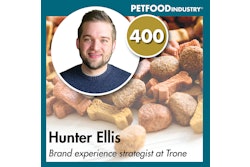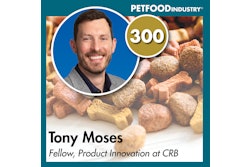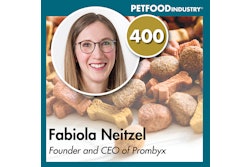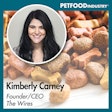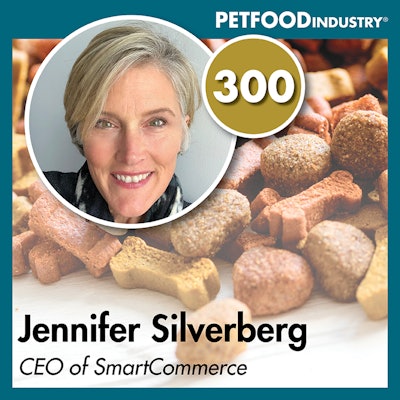
Grab a fresh cup of coffee or aim for a 30-minute workout, because this episode goes the full half hour and covers a lot of ground. CEO of SmartCommerce Jennifer Silverberg and I talked about all things marketing strategy in 2023, including what pet food customers really want and how brands can break free of their traditional plans in order to rise to the top. This one's a must-listen.
The below transcript is from Episode 26 of the Trending: Pet Food podcast, where I spoke with CEO of SmartCommerce Jennifer Silverberg about the “MeComemrce” Era and how to navigate advertising strategies to pet owners to suit their current needs. You can find the episode at www.PetfoodIndustry.com/trending-pet-food-podcast, on SoundCloud or on your favorite podcast platform. This episode originally aired on January 18, 2023.
(We want to thank AFB international for sponsoring this podcast. AFB is the premier supplier of palatants to pet food companies worldwide, offering off-the-shelf and custom solutions that make pet food, treats and supplements taste great.)
Lindsay Beaton – Editor, Petfood Industry magazine and Host, Trending: Pet Food podcast
Hello, and welcome to Trending: Pet Food, the industry podcast where we cover all the latest hot topics and trends in pet food. I'm your host and Editor of Petfood Industry magazine, Lindsay Beaton, and I'm here today with Jennifer Silverberg, founder and CEO of SmartCommerce. Hi, Jennifer, and welcome.
Jennifer Silverberg – Founder and CEO, SmartCommerce
Hello. So great to be here. It's my first pet food podcast.
Beaton: In case you’re not familiar with Jennifer or her company, here’s what you need to know. Jennifer works with an international team to help major CPG brands own and drive their customers’ buying experience. She has more than 30 years in the industry working in senior marketing and leadership positions with brands ranging from startups to Fortune 50 companies. Prior to founding SmartCommerce, Jennifer led marketing at Channel Intelligence, one of the world’s leading commerce technology partners that was acquired by Google in 2013. She’s also the co-host, alongside Risa Crandell, of CPG Scoop, which can be found at www.cpgscoop.com.
SmartCommerce is the SaaS solution used by leading CPG/FMCG brands to enable one-click conversion of one or many products from any digital impulse point, into virtually any retailer cart. SmartCommerce’s Click2Cart technology removes the friction that has limited the potential for digital impulse purchases for fast-moving consumer brands. This means that brand ads, social media, websites, videos and other channels that once built only awareness are now direct e-commerce response points, collectively driving more than $3 billion of products into retailer carts in the last 12 months.
Jennifer’s expertise in all things consumer makes her exactly who I want to speak with in order to answer today’s question: What are the pet consumer forces behind the "MeCommerce" Era?
And we are going to define the MeCommerce era in just a moment, but I want to start our conversation, Jennifer, with how the shopping landscape has changed — because changed it has, especially in the last several years. So what are we looking at in terms of pet owners and their shopping landscape?
Silverberg: I think what's so interesting — and a lot of people have already said this so I'm not saying something new here — most people are pointing to COVID-19 as the driver of the change. We see COVID-19 as an accelerator of the change, but not COVID-19 as the driver of the change. The changes have been happening for a very long time. In order to kind of lay out how we wound up at MeCommerce, which is just a term we use internally to describe where we are now and what we see changing now, we have to go back in time to sec. Really when I look back — and some of this actually predates me being an adult — but when we look back as a team at the history of commerce and the way that commerce developed, we see three distinct eras.
The first era was really the beginning of marketing. And it was very, very brand-driven. It was the 1960s through the 1980s–90s. And it was when marketers like Procter and Gamble and Unilever and some of these guys first recognized the value of the brand and the value of using the brand to drive a consumer to go make a purchase in the future. And really, the brands were using the set of media that was available then which, you know, these were back in the days where you could reach 90% of U.S. consumers on a random Tuesday night because it was a TV show that — you just had to cover the right TV shows. You could reach them because they were all sitting out there doing the same thing together, and so it was very brand-driven. Brands met with retailers, and the relationship was: There's always a little bit of adversarial relationship because brands don't care where you buy it as long as you buy it from them and retailers don't care what you buy as long as you buy it at that retailer. But there was a partnership between brands and retailers where the brands drove a lot of the discovery of products and drove the consumers to the store to buy those products.
As we went into the ‘80s and ‘90s and we saw the fracturing of media, going from three channels at night to 3,000 channels at night to now going into the internet and God knows where everybody is, it's very difficult to reach that kind of audience. The role of the retailer became way more important in terms of product discovery and making sure that a product would be found when a consumer went in. So the primary role of driving consumer discovery moved from that brand-driven era at the beginning into a retailer-driven era where the brand's job was to make sure that they stood out on shelf. So you saw packaging evolve quite a bit because the role of packaging was to make sure that it jumped off the shelf and then people saw it.
Media changed quite a bit and now we've seen as this era has peaked, even retailers getting in the space of understanding the value of their audience and the relationships that they have, and getting into that media space as well. But what's happened in there is we've created a bit of where something used to be a balanced relationship between the brand and the retailer, really balancing kind of heavily in the favor of the retailer, to where the brand now is paying the retailer not only to reach their consumers in the store, but also to reach them beyond the store in the form of the media and in the form sometimes of events and other things that the retailers are doing. And it's created a bit of an imbalance and something that has become semi-stable in balance.
Now, underneath all of that, we also were having consumer enablement starting to grow. So the early 2000s, we saw consumers starting to be able to get into price comparisons online. Once the internet came along, now there's something that the consumer has it sitting in their hand that lets them say, “Yeah, brand, I know what you're saying and yeah, retailer, I know what you're saying, but I have some power. Now I have some technological power, and I'm going to use it.” That's when price comparison engines came in and online stores came in. And other things were essentially the consumers bringing that entire shopping experience to them, rather than it being controlled by somebody else. And they decided what got through.
And then at the same time, over the last six to 10 years, we've seen a real crumbling of what have been the standard pillars of how consumers feel safe, and where they get information and the control factors and things like that. We've seen a crumbling of consumers feeling confident about the political leaders, which is the traditional stabilizing force, we've seen consumers get less confident about the media — I mean, we used to turn to the media as a place to get information that was unbiased, and now I think 97% of consumers said that they feel not confident about media, because so much bias is coming through it's just getting really difficult to find an unbiased source. And so they're actually more turning to each other, whether it's through social media and the ways that they connect with each other there, or direct social media texting with their friends and family, getting together with their friends … they are really turning to each other and away from some of these traditional pillars, and really away, from a commerce standpoint, away from being online in a place where they can be influenced by media.
And so the brands and the retailers are needing to find new ways to reach these consumers. And when they're really only listening to each other in this space, when they're really in those social spaces, whether it's social media per se or whether it's just them interacting with each other, the value of the consumer-to-consumer … kind of going back to word of mouth, it's almost like the Agora that happened before the whole brand space or the retailer space.
And so internally in trying to grapple with this, and in trying to watch the behavior — because we're very behavioral, we want to watch what consumers do, not what they say they do — and in trying to understand that we've internally started calling it MeCommerce, because people were saying, “Is it e-commerce or commerce? and I'm like, “It's all of those things.” But instead of starting from a brand, as it was in the brand era, or starting at the retailer, as it was in the retailer era, it's starting from that moment that the consumer recognizes that they want a product. And that may be when they're talking to a friend, it may be when they run out of the product they have, it may be when they have dissatisfaction with the product that they have and they want to open their minds to something else. It might be because they see an ad when they're on Pinterest or when they're on Facebook or when they're on TikTok or whatever it might be that they see a product, they experience a product, they hear about a product, they recognize the need of a product increasingly.
And again, accelerated by COVID-19, consumers are going to be expecting that in the moment that they recognize that they need something, in the moment that I see that my dog is having diarrhea right after I changed their diet, in the moment that I see that my dog is outgrowing their bed, in the moment that I see that my cat doesn't like playing with any of her toys anymore, I'm going to expect to be able to find the answer to that situation in the form of a product and product recommendations that come from a trusted source that aren't necessarily a retailer or brand because I understand their pieces. It might be, if I can I believe that the data that's coming to me from them is actually in my best interest, not in theirs. But I'll have filters about that. But I'm going to expect that that information is going to come to me immediately, and I'm going to be able to solve that problem at a product basis now, and I'm not going to have to go somewhere and go get it or trust some third party that I don't know.
Beaton: You talked about these traditional pillars crumbling and consumers going different places to get their information now, and there's a real push in the pet industry — and I have to assume other industries as well, because pet food consumers are also consumers of everything else — to do more relationship building. Things used to be very transactional, now they clearly are not. You just talked about it. I've seen it. People want to know what the brands stand for that are in their pantries, whether it's pet food or not I assume, but there is on top of that, that distrust of brands and media, and “Of course they're going to tell me these things. They're trying to get money from me.” Is there any way for brands to break through that and be the people who can give the information to consumers, but also be truly authentic about it to the point where consumers believe them? Is it just going to take time? Is there something radical that companies need to be doing to make this happen?
Silverberg: That is such a great question. And to answer that, I'm going to say we are finding that relevance is a huge lever in this space. And we have found that irrelevance is a huge destroyer in this space. So let me talk about why we use the word relevance. First of all, when you walk into a grocery store, there's an average of about 30–35,000 SKUs inside, just a typical grocery store. And an average consumer buys 220 different SKUs in a year. So if you thought about a media landscape where over 99% of what you hear is spam, typically in the media landscape I can kind of filter some of that stuff out. But when I walk into a grocery store, I literally have 99% of what I'm being shown is spam to me. We just accept it because that's the way we've always had to shop. We've always had to walk down an aisle that we don't want anything of and we avoid the aisles we don't want, but we still walk down aisles that are covered in stuff that we don't want anything to do with. Every single time a consumer is shown all of that, it breaks the trust just a little bit more and it makes the space that they're in when they're in a store or what they're seeing when they're on a website or the ad that they're seeing, it makes them believe you're just trying to sell them something.
Brands need to really weigh those two things and realize that anything that they give me that is relevant, meaning I was open to hearing it, I needed to hear it, it answered something that I know is an issue or that you can tell me is an issue for me and is valuable, that increases the relationship [and] these repeated messages that are off-relevance damage the relationship. So you need to be really careful to not just think that the negative ones are neutral; they're not, they're literally negative and they're hurting, and the positive ones that are relevant, are actually increasing. For brands to really step back, the core tenet of MeCommerce really needs to be: How do I put myself in the shoes of the consumer and make better decisions so that I won’t be perceived as a negative to the consumer, but so I am perceived as a positive to the consumer.
Talking to the consumer at a moment that they're not interested is an immediate irrelevance, even if it's a relevant message. Talking to the consumer on a platform that feels irrelevant, we all personally just go, “Seriously?” And you just close that thing. And you have a mild irritation, even if it's a brand I like, it's like what are you doing on there? Thinking about when you're reaching somebody and then making sure that you're reaching them with something that's valuable to them, not just valuable to you. Somebody said to me the other day, they said the words: “We need to serve an ad because we should, not an ad because we can. We need to send an email because we should, not an email because we can.” What I'm saying is not easy. It's very hard to do at scale. But it also is massively valuable to the brand long-term.
And one of the places we're seeing a lot of success on it is through influencers, because whether it's micro influencers, which I actually kind of lean towards, versus some of those macro influencers is they're doing a lot of the work for the brand of figuring out when it's time to talk about something. And they will tell you! If you tell an influencer, “You know, on Mother's Day, I want to do a thing about pet diarrhea,” they're gonna say, “That's a terrible day to do a thing about pet diarrhea. This is a feelings day.” I know you're laughing, but it happens. And a brand will say, “Well, this is a pet diarrhea month, I want to talk about that.” The influencers are great about saying, “Why don't I wait until my pet experiences this and then I can talk about it authentically?” Really, influencer I think is as much about broadening your marketing team to include a bunch of people who have a closer relationship with consumers every day as it is about a media platform, because they will help you and they will give you information back and go you know, every time I do that consumers get mad. And if you hear that you better pay attention because they are closer to your consumer than you are.
Beaton: I think it's interesting that you bring up influencers because they have so quickly gone from being a bit of an eyeroll situation where people are like, “Oh great, look at this. Some random person or celebrity is trying to convince me that they are big on this product they never even heard of before, they made this brand deal,” to what you said, which is a potential key member of a marketing team for a company. And I think that we might be at a tipping point in terms of influencer culture, where we're gonna have to stop looking at them as those more inauthentic, “they're faking this for the camera” type of deals and more in terms of “No, this is a member of my marketing team. This is a way to reach people authentically, where they might not listen if it's coming straight from me.”
But if somebody else is telling them, look, this is my pet, this is what happened, this is what worked for me, it just comes across better, even if you know that they're working for the brand or that they absolutely have a sponsorship, because one thing a lot of influencers are really good at is transparency. They tell you straight up, “I am partnered with this particular brand. Here's what the deal is. Now, here's my experience.” And I think that resonates with a lot of people, because we all have experiences with brands, we just don't all have platforms to talk about them. And we sure do ask our friends and our family members for advice when they're dealing with those brands. So I think a shifting look at who influencers are and what role they're playing in modern-day marketing is a really important conversation to have.
You've mentioned a few of the challenges in terms of traditional commerce areas and ways that traditional marketing just really needs to evolve right now. What are some of the pain points that you're seeing right now in terms of people, or companies either wanting to stick to their traditional marketing strategies or trying to make moves but not quite knowing where to go? Are there things that companies are still doing right that they can grow this off of? Or is this such a seismic shift that we need to start throwing out the marketing playbooks and just try to do something completely new? What point are we at in the traditional versus new?
Silverberg: I love the way that you ask that question. And I hope I can do it service, because it's such a great question. It's never in any big company's best interest to throw out everything they're doing and start over; there's equilibrium to take into account for sure. But there's lessons for them to take last year's plan and just assume that it's going to be incremental ups and downs on those percentages and go, “Well, you know, I'm just going to turn that dial this much and this dial this much and this dial this much.”
If I were CMO of one of the big companies that I know listen to you, I would do a really serious exercise that said, just for a minute, take everything that we're planning to do. And let's put it over there. And let's say if we were building a marketing team right now, if we were building a marketing budget right now, understanding everything we know about the consumer and the way they behave and what's going on in the very much moving and changing and shifting space of retailer and brand, what would we do? What would we be putting into our partnerships with our retailers? Meaning, what would we be doing in-store? And what would we be doing on our packaging? Let's think of all the different touchpoints we have to the consumer; what's our consumer doing? So let's draw a picture of our consumer right in the middle of this blank page. And let's start saying, what does your day look like? What are our potential touchpoints of her — not our traditional touchpoints of her, which are ads and maybe social and in the store — when is she open to hearing from me? What is the message that she needs to hear from me in order to make the change? How do we get that message to her in a way that we can afford to do it? And then a really important piece that often gets overlooked is: How do we maintain that relationship over time?
And so I'll be willing to bet that if somebody did that with a big white sheet of paper or a giant white wall somewhere and they built this out that it's not going to look like what their plan looked like last year, it's not going to look like incremental changes, and their spending’s going to shift around from some of the pieces that have been traditional to some things that are new and interesting. And then it becomes the CMO’s job to figure out how they're going to navigate from here to there. And I think you don't want to change everything at once, because you have relationships and you have plans and you have all of these things. So you have to figure out what can you change; which are going to be the most impactful changes. And then most important, how you are going to reward that change within your organization rather than rewarding stasis.
The way that a lot of brands are set up is you have managers of each of your customers. You have a customer manager for Amazon, a customer manager for Walmart and a customer manager for Chewy, and those are typically bonused for growing something in that space. And in many cases, that means going deeper in with that retailer. Well, you may have just said we're gonna go do something else over here. So you're gonna have to reallocate the way that these teams are bonused so that you reward invention and new ideas and innovation as much as you reward maybe even immediate outcomes. You may need to put a portion of what you're doing in a bucket that is rewarding innovation, even at the cost of this quarter or next quarter. It had better be pretty soon that you see something after that, because you know, the world that we live in, I'm not being Pollyanna, but build an innovation budget and reward that innovation budget. Because otherwise, if you're only rewarding incrementalism on the things that you're already doing, you're going to get more of what you're already doing.
And it's going to put you in a position where eventually you're going to see that somebody else has innovated right around the behavior that you were supporting. We saw that happen last time, now we're going through another major shift from this retailer-driven space to — and I'm not discounting the retailer, by the way, the retailers are still a huge, huge portion of this other piece, they're just not the driver necessarily of consumer discovery — but as we go from this retailers base to the consumer space, we just have to rethink, maybe it's how you work with the retailers, it's not taking something away there. It's just shifting the way that you think about it and making sure that it's driving the thing that the consumer wants. Because if you successfully come up with a great program for brands and retailers right now that doesn't work the way the consumer wants it to it will still fail. We have to figure out what does the consumer want, how do we all work together as a category to give the consumer more of what they want. And those are the brands that will win.
Beaton: We've sort of naturally been coming at this from a larger company perspective, because they tend to have the most established marketing and they usually have the revenue to backup more significant changes and budgets and things like that. But one of the things I love most about the pet food industry is how many small- to medium-sized companies there are and how so much of the innovation comes from these smaller companies just because they can be more flexible, they can work a little more quickly when it comes to trying a new thing or new products. And as a result, a lot of them are very tuned in to consumers and they're more willing to try new things in this new era that we're rolling into, into this MeCommerce era. Do you think that flexibility is going to be more of an advantage than strictly having the budget to do things? Is it going to take a combination? Who has the advantage right now when it comes to making these sort of changes in terms of company size?
Silverberg: The big ones always have the advantage. I mean, let's be real, because they have the budget that they need. But the flexibility is unprecedented in being able to reach a consumer, and speed. Flexibility is one thing, that's the ability to do something different, but the scrappiness and the speed to be able to make a change is even better. When I think about the pet food space there are two places that I am astonished that none of the brands are really leveraging — and these are things that would be by definition harder for a big company to do than for flexible ones.
The first one is the brands are, for some reason, not understanding that they have a benefit that nobody else in this space has. They have a package that is sitting inside my house. What do you think a retailer would do if they could have a two-foot … actually I know what a retailer would do with a two-foot-by-one-foot space because we've seen what Amazon has done with the Alexa; brilliant stuff with that, right? And it's this big and it doesn't say anything on it. You have a package that's two-feet-by-one-foot and for some reason that brand does not give me any way to reorder from them, to engage with them, to do anything with them on this package. Why are you not putting a QR code on the packaging to let me reorder? Why are you not putting anything on that product to let me easily reorder off that? You know, if I had this conversation with large pet food retailers they're gonna go “Oh, well, you know, there's a 47-stage process to change my packaging” and all of this kind of stuff. And I'm gonna go, “What about sampling?” And they're gonna say, “Yeah, we're gonna do samples in fourth quarter 2027. And that's on our roadmap.” But if you're a little guy, do that today. And here's where I get a little selfish. The QR code ought to open something that shows all the retailers where you can buy it, and you ought to be able to drop it in your cart from there. We (at SmartCommerce) do that. So that's why I've been preaching this thing for five years. It's not just good for the brand, it's good for the consumer. This is one of those opportunities where the MeCommerce is good for everybody. And it should be fulfilled by the retailer. So this is a win-win-win that's sitting out there.
The other thing is, I was at the dog park the other day and they were out front selling dog treats to be able to raise money to take care of the dog park. And I thought, how much are they going to make in dog treats? $500 or something all weekend with all these people sitting out there? For $500, if I were a little pet food brand, I'd have a sign up in there. I'd give them $500 and I'd put a sign inside of this dog pen and I would reach everybody who takes their dog out to interact with other dogs. It goes back to guerilla marketing and it goes back into again, relevance, you know, that's a moment where it's relevant. Because when I'm watching my dog run around, I'm either on my phone or I'm talking to somebody or I'm looking around bored out of my mind, because this is for them to have fun, not me to have fun. And so I would read something and I would interact with something. And I would probably put a QR code on there as well, that gives me — now, off the package, I'm probably there seeking information, there seeking to reorder. When I'm out, I am seeking to engage and entertain and learn. That ought to be true while you're waiting at the vet, that ought to be true with anything that the vet sends home with me, if we just think about the touchpoints. C
By the way, it's you know, consumers are actively shopping 17 minutes a day. 17 minutes. So they're either in a store or they're on retailer.com. And that's actively shopping, like: I woke up this morning, I knew I need dog food, I went to target.com or chewy.com or wherever. That 17 minutes is so crowded and fraught with the retailer space and other brands trying to fight with you and all that kind of thing. There's the whole rest of the day that you can interact with this consumer if you just think about how to reach them in the moments that they're not doing this other stuff. In other words, a lot of brands are competing for the same 17 minutes. And there will be successful brands, particularly to your point, the scrappy ones, that will reach consumers outside of the space of those 17 minutes, or drive repurchase outside of those 17 minutes that can win against some of these bigger ones.
Beaton: Before we wrap up, I want to give people somewhere to start, because we've covered a lot of ground and we've given everybody listening a ton of information and a ton of stuff to think about. Where should people start with all of this? What is the number one thing people should wrap up this podcast, head into their marketing office, head into wherever they're going after this, and do?
Silverberg: What I suggested before, where I think if you stop what you're doing and you put your plan for next year face down, which maybe this is a great time to do that because most people have completed and already gotten approval on that, let's just do an exercise. If we were going to throw it away and we were going to start over today, but we were going to start over not from last year's budget, which is what everybody does, you have to do that because it's a giant budget, right? But if we weren't going to do that, and we were going to rebuild from scratch, what would that look like? And just do that and then say: How many of these things can we afford to do next year, and which do we think are the most valuable, and let's try some of those.
The second thing is going to be, I would make everything shoppable. If you're going to have an ad make it easy for me to take an action on it. Stop thinking that giving a consumer a way to bridge to a purchase is a bad thing. It's a valuable, helpful, useful kind of thing. And I guess one of the things I always try to remember is, there's a reason we call them consumers. We are consuming all the time. We're not just consuming in the 17 minutes that we're in a store, we are discovering products and making buying decisions all of the time. So those would be the things, and sorry that second one was selfish. It is the lens through which we see things. And we see millions of dollars of products and carts off of things that previously had only driven consideration.
And look at your package, for the love of God. Go home tonight — that's what you should do. Go home tonight and sit your package on the counter and go, What else could I be doing with this? It was probably designed to look different at shelf than everything else. Let's assume for a minute that they're ordering it online. How do we make it jump off the page? How do we make it something that I want to leave out? How about that, if somebody had a pet food package that was so beautiful that I left it out? I would use it more often, I would use it as a treat, I would do all of these kinds of — you know, what else could I do with it, including, of course, triggering repurchase. Ask that question and leave it sitting out and force yourself to think harder about using the things you already have.
Beaton: I really want to thank you for being on today, Jennifer, because consumers have more influence than ever when it comes to all of this — when it comes to brand business, when it comes to communication styles and marketing. And I really think that we are at a tipping point, we are headed towards a new way of doing things and we're already in the midst of a lot of it. So it's a good time for companies to sit down and think about their strategies and think about the ways they're not reaching their consumers. Because those are the opportunities and the challenges, because if your competitors are utilizing those channels and doing it well and you're not, then like you were talking about with the first time this huge shift happened you're going to be left behind and that's not what anybody wants.
Before we go, I always like to do a little plug. So where can people find more information about you and SmartCommerce?
Silverberg: You can go to www.smartcommerce.com to learn more about us. I am always open to questions, challenges, talking about marketing. One of the ways I learned is people reaching out to me directly, so please feel free to email me: my email address is [email protected] That’s about it!
Beaton: Perfect. That is it for this episode of Trending: Pet Food. You can find us on www.PetfoodIndustry.com, SoundCloud or your favorite podcast platform. You can also follow us on Instagram @trendingpetfoodpodcast. And if you want to chat or have any feedback, I'd love to hear from you. Feel free to drop me an email: [email protected]. And of course, thanks again to our sponsor AFB International, the premier supplier of palatants to pet food companies worldwide offering off-the-shelf and custom solutions that make pet food, treats and supplements taste great. Once again, I'm Lindsay Beaton, your host and Editor of Petfood Industry magazine, and we'll talk to you next time. Thanks for tuning in!



